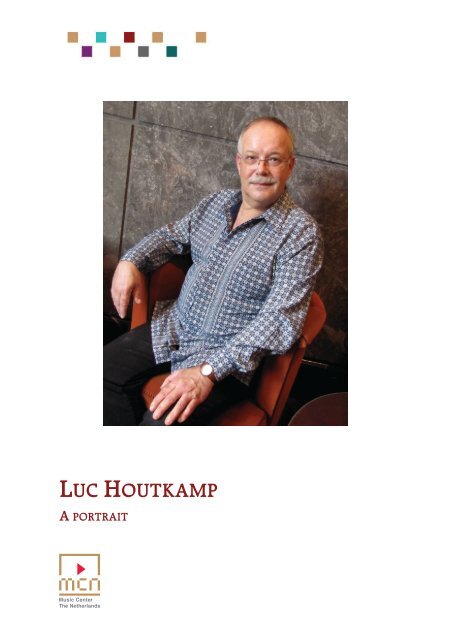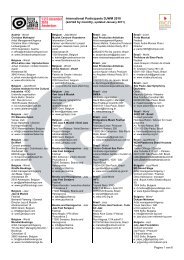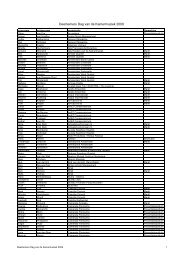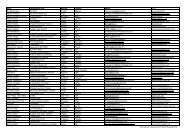LUC HOUTKAMP - Muziek Centrum Nederland
LUC HOUTKAMP - Muziek Centrum Nederland
LUC HOUTKAMP - Muziek Centrum Nederland
Create successful ePaper yourself
Turn your PDF publications into a flip-book with our unique Google optimized e-Paper software.
<strong>LUC</strong> <strong>HOUTKAMP</strong><br />
A PORTRAIT
CONTENTS<br />
Biography .............................................................................. 3<br />
Dirty hands, Clean aesthetics .............................................. 4<br />
Compositions ....................................................................... 7<br />
Compact discs ...................................................................... 8<br />
Publications on the composer .............................................. 9<br />
Copyright © 2010 by Music Center the Netherlands<br />
Music Center the Netherlands is the resource and promotion center for the professional music world.<br />
Its mission is to propagate and enhance the position of Dutch musical life, both nationally and internationally.
Luc Houtkamp - a portrait - 3<br />
BIOGRAPHY<br />
Luc Houtkamp (1953, Den Haag) is a composer who<br />
bridges the gap between different musical worlds.<br />
Having a background in jazz & improvised music as<br />
an alto and tenor saxophone player, his musical goal<br />
is to establish a continuum between improvisation<br />
and composition in which the difference between<br />
the two is dissolved. With the aid of computers and<br />
live electronics as well as various forms of music<br />
notation, his compositions are highly personal in<br />
both sound and concept. Here, stylistic freedom is<br />
not a post-modern cliché, but based on Houtkamp’s<br />
firm belief that musical style is secondary in importance<br />
to and can serve the expressive quality of the music itself. His main<br />
interest as is evident in his pieces is the way in which the musicians play together,<br />
and how this can be directed by means of composition and the use of<br />
computers.<br />
After a long-standing career as an improvising musician, Houtkamp<br />
established his own POW Ensemble in 2002. Being a flexible unit of musicians<br />
with musical backgrounds in jazz, rock, electronic and contemporary<br />
music, the ensemble soon became the ideal unit for the performance of his<br />
own compositions.<br />
In 2004 Houtkamp received the VPRO/Boy Edgar award, a prestigious<br />
award for jazz and improvised music in the Netherlands.<br />
Luc Houtkamp has been a teacher, lecturer and composer in residence<br />
in electronic music composition at numerous universities and music<br />
conservatories, in, amongst others, Johannesburg, Durban and Grahamstown<br />
(South Africa), Odense (Denmark), Lüneburg (Germany), Hilversum and Den<br />
Haag (The Netherlands). In 2010 – 2011 he will be an academic tutor in composition<br />
to USA Fulbright scholar Seth Rozanoff.<br />
Houtkamp was a member of the jury at the 2009 Gaudeamus Interpreters<br />
Competition, The Netherlands. From 2000 – 2008 he was a member of<br />
the artistic board of Stichting Gaudeamus. Further, he has been an active<br />
board member of various musical foundations in The Netherlands such as the<br />
Conlon Foundation (to further the development and use of new and existing<br />
‘MIDIfied’ acoustic musical instruments), the Association of Dutch composers<br />
(GeNeCo), the Union of Improvising Musicians (BIM) and the BUMA Social<br />
fund.
DIRTY HANDS, CLEAN AESTHETICS<br />
Luc Houtkamp is a man who hates to get his hands dirty. Setting out in life<br />
with plans to become a visual artist, he soon abandoned paint and ink in preference<br />
for the cleaner art of music. And it seems he has a taste for order, too,<br />
his apartment containing nothing less functional than his much-loved cat<br />
Mingus. That said, it does contain a fair amount of stuff, another indication,<br />
perhaps, of the inspiration Houtkamp draws from a diverse range of sources,<br />
both at home and in his work. And certainly, the dexterity with which he<br />
manages to synthesize the most unlikely musical elements in his work seems<br />
to be a testament to a highly organized and deftly analytical mind, qualities<br />
he employs to create music that is generous, funny and surprising.<br />
Starting life as an improvising jazz saxophonist in the early 1970s, Luc Houtkamp<br />
has gone on to make extensive explorations of both electronics and<br />
composed structures in his music, and has, along the way, had the pleasure of<br />
working with a huge range of musicians across all genres. But it is perhaps<br />
Houtkamp's work as a teacher that has been most formative, with a period in<br />
the late 90s at the University of KwaZulu Natal in Durban having a significant<br />
impact on his approach to making and sharing music. The fundamental political<br />
changes taking place in South Africa at the time confronted Houtkamp<br />
with some vital questions of context, as an almost exclusively Zulu first-year<br />
intake of Maskanda and Indian Bhangra musicians, jazz drummers and gospel<br />
producers had somehow to be accommodated within the academy. With Western<br />
art music clearly providing an insufficient framework for teaching such a<br />
group, Houtkamp found himself faced with some fundamental questions regarding<br />
musical style and performance practice. And for him, the answers lay<br />
in abandoning questions of style altogether, in preference for more flexible<br />
strategies of communication between musicians. After all, if the musical conventions<br />
that constitute a particular 'style' are only a means by which musicians<br />
can communicate with one another, the moment they cease to serve<br />
their purpose they must be re-assessed or abandoned. Luc Houtkamp's music<br />
is a constant and often playful negotiation of both these possibilities.<br />
An exemplary demonstration of Houtkamp's aesthetic can be found in his<br />
extended BoX of BriX project of 2010; an assemblage of components compiled<br />
according to its own uncanny principles of construction, its own surreal<br />
rules of play. Despite the distinct character of the constituent modules that
Luc Houtkamp - a portrait - 5<br />
make up BoX of BriX, however, Houtkamp's intention here is in fact to explore<br />
the possibilities of musical continua between these blocks, with specific<br />
lines of continuity, specific modes of transition, forming the constructive<br />
backbone of the piece. Houtkamp describes his approach to form here as an<br />
extension of Stockhausen's concept of compositional structure, where the<br />
overall form is perceived as a kind of 'timbre', driven by the relationships<br />
between, and coloured by the constituent components of, melody, harmony,<br />
meter, rhythm and amplitude. For Houtkamp, however, investigating lines of<br />
continuum between improvisation and composition, and the possibilities for<br />
morphing or splicing between musical styles (boldly declared only to be yet<br />
more boldly dissolved), is also an essential part of the composition process,<br />
along with an integrated use of electronic and acoustic instruments and liveprocessed<br />
acoustic sound.<br />
What then of the relationship today between Houtkamp's work as performer,<br />
improviser and composer? In the light of his African experience it will come<br />
as no surprise to hear that Houtkamp prefers to have personal relationships<br />
with the musicians who perform his work, or to be directly involved in the<br />
performance process itself. But as he points out, historically, this has been<br />
always common practice: until, that is, the late-Romantic preference for having<br />
star conductors mediate the genius of a composer's mind through the<br />
vast medium of the orchestra. Duke Ellington, however, wrote music for the<br />
members of his band, working as composer, performer and improviser, much<br />
as Bach had done centuries before him. And in the 21st century, with electronics<br />
bringing improvisation back into the processes of both composing and<br />
performing, Houtkamp can make full use of what he describes as a more healthy<br />
creative situation. That said, Houtkamp has also begun to establish a<br />
catalogue of composed works, for the most part developed in close collaboration<br />
with musicians, but not by any limited to performance by them alone.<br />
Uiterste Staat (Utmost State, 2008/09 for electric guitar and two computers)<br />
for example, is a three-movement work defined by extremes, with meticulously<br />
notated virtuosity, guided improvisation, modulation-free tonality and<br />
crackling electronic sounds proceeding through rapid exchange and in quick<br />
succession. Like BoX of BriX, Uiterste Staat employs familiar objects, structures,<br />
timbres or styles as the frame through which we can experience something<br />
new and for this reason it is equally demonstrative of Houtkamp's core<br />
composition concerns.
It is, however, only since around 2002 that Houtkamp has begun to describe<br />
himself as a composer at all, his main musical activities having previously<br />
been specific to improvisation and the writing of interactive computer programs.<br />
And despite his early studies in the plastic arts, it is the relationship<br />
between music and dance, and specifically in jazz and African forms, that is<br />
most evident in much of Houtkamp's music. The fact that many African<br />
countries use only one word to describe both music and dance, clearly demonstrates<br />
how interrelated the two practices are on that continent, and for<br />
Houtkamp this is also true of jazz music and dance of the 1930s, and something<br />
he aspires to in his own work. This goes some way to explaining the<br />
unusual and highly versatile combination of performers Houtkamp brought<br />
together when he formed the POW ensemble back in 2001, in which computers,<br />
acoustic and electronic instruments, live electronic processing and turn<br />
tables can often be heard performing with an unusual addition to their<br />
rhythm section: tap dancer, no less.<br />
In many of his projects, Houtkamp's main goal has been to create music that<br />
is essentially improvised but nonetheless gives an almost symphonic feel of<br />
being through-composed, with themes, counter-subjects, variations and other<br />
traditional formal constructs. And although he professes admiration for many<br />
jazz musicians, the traditional structure of jazz performances, with improvised<br />
variations sandwiched between opening and closing statements of the theme,<br />
is something Houtkamp has always strongly disliked. So, rather than putting<br />
improvised and composed structures side by side, it is the act of smelting<br />
them together that excites Houtkamp, who is more than happy to get his fingers<br />
metaphorically very dirty in the musical melding and formal moulding of<br />
his materials. This combination of rigour and flexibility has proven central to<br />
the formation of Houtkamp's creative personality and distinctive compositional<br />
voice. For Houtkamp, cultural and personal identity is fluid, finding power<br />
in change. But what is exciting about the music he makes is that this change<br />
does not take place without resistance; without jagged juxtapositions, musical<br />
anomalies and moments of surreal humour acting as counterweights to the<br />
unifying musical forces Houtkamp is constantly searching out.<br />
Alwynne Pritchard, 2010<br />
photo cover: Adri van den Berg<br />
photo p. 3: Bert Niehuis
Luc Houtkamp - a portrait - 7<br />
COMPOSITIONS<br />
ENSEMBLE PLUS ELECTRONICS<br />
BoX of Brix (2009-2010)<br />
duration: 60’<br />
lyrics: William Blake, Han Buhrs, Luc<br />
Houtkamp<br />
2voice fl sax-a vla vc cemb ukulele 2synth<br />
3comp live-electr soundtracks<br />
Uiterste Staat (2008-2009)<br />
duration: 16’<br />
el.git 2comp<br />
8 pieces for Homage to Hazard<br />
(2007-2008)<br />
duration: 45’<br />
lyrics: Han Buhrs, Guy Harries<br />
2ten fl sax-t trb vc 2synth 2comp live-electr<br />
Masnavi Molavi (2005), together<br />
with Guy Harries<br />
duration: 60’<br />
lyrics: Kader Abdolah, Jalaluddin<br />
Rumi, Guy Harries, Luc Houtkamp<br />
2voice recit sax-t perc keyboard vl vla vc ud<br />
saz 2comp dj-set<br />
ELECTRONIC MUSIC<br />
Exercise in Swing (2001)<br />
duration: 47’<br />
soundtracks<br />
Ton Sur Ton (2002)<br />
duration: 8’<br />
soundtracks<br />
SOLO-INSTRUMENT AND SOUND<br />
TRACKS<br />
The Way Up (2000)<br />
duration: 15’<br />
sax-t soundtracks<br />
The Way Down (1997)<br />
duration: 15’<br />
sax-t soundtracks<br />
Odd & Even (1986), with Tony van<br />
Campen<br />
duration: 16’<br />
sax-t soundtracks<br />
INTERACTIVE MUSIC<br />
Duo for Man Alone (1997 – 2004)<br />
duration: variable length<br />
for single voiced solo instrument, computer<br />
and MIDI-controlled piano<br />
Rebounds (1994 – 1997)<br />
duration: variable length<br />
for single voiced solo instrument, computer<br />
and MIDI-controlled piano<br />
Vogeltrek (1992)<br />
duration: variable length<br />
for single voiced solo instrument, computer<br />
and MIDI-controlled piano<br />
The Rule of Thumb (1991)<br />
duration: variable length<br />
for single voiced solo-instrument, computer<br />
and harmonisers<br />
MUSIC THEATRE<br />
Dulcinea, Dulcinea (1989), with<br />
Gilius van Bergeijk<br />
duration: 60’<br />
visuals and scenery: Adri Boon<br />
actress sax-t soundtracks 2synth comp liveelectr
COMPACT DISCS<br />
POW ENSEMBLE<br />
Continuum<br />
Luc Houtkamp/ POW Ensemble<br />
X-OR CD020, 2010<br />
Homage to hazard live<br />
Amsterdam 2008, POW Ensemble<br />
X-OR The Field Recordings 14, FR 14, 2008<br />
Birdsong from inside the egg,<br />
POW Ensemble.<br />
X-OR CD019, 2006<br />
The thirteen bar blues<br />
Houtkamp's pow3<br />
X-OR CD017, 2003<br />
<strong>LUC</strong> <strong>HOUTKAMP</strong><br />
Exercise in swing<br />
X-OR CD 011, 2001<br />
Luc Houtkamp in Chicago<br />
Entropy Stereo 00, 1997<br />
Live in Canada '97<br />
The Field Recordings 6<br />
X-OR FR 6, 1997<br />
The duo recordings<br />
The Field Recordings 7<br />
X-OR FR 7, 1998<br />
Live in Geneve & Luzern<br />
The Field Recordings 1<br />
X-OR FR 1, 1994<br />
Metslawier<br />
X-OR CD 05, 1994<br />
The Rule of Thumb<br />
X-OR CD 03, 1993<br />
The Songlines<br />
X-OR CD 01, 1992<br />
OTHER ENSEMBLES<br />
#40 Vienna & #41<br />
Bernbeuren, 2003, FOURinONE<br />
The Field Recordings 13<br />
X-OR FR 13, 2003<br />
Burnt sienna, 2nd Outlet<br />
Nuscope Recordings 1015, 2003<br />
Beyond the edge<br />
O.BA.O/Luc Houtkamp<br />
EWM 51712, 2003<br />
Stelen, FOURinONE<br />
Random Acoustics RA026, 2000<br />
Live at Free Music XXVII<br />
Antwerp, 2000, f.i. quartet<br />
The Field Recordings 11<br />
X-OR FR 11, 2000<br />
Binaurality<br />
King Übu Orchestrü<br />
FMP CD49, 1992<br />
STEAM-Group + Sven-Åke Johansson<br />
at the Roundhouse<br />
London 1972 SÅJ-CD 15, 1972 (released<br />
in 2008)
Luc Houtkamp - a portrait - 9<br />
PUBLICATIONS ON THE COMPOSER<br />
“The reason why I want to use electronics, especially computers: one of the<br />
ideals in my music is to combine composition with improvisation in such a<br />
way that you can't say what is improvised and what is composed. Computers<br />
can help you with that. I write interactive programs that can respond to improvisers.<br />
In those programs, I write the rules for a composition, the possible<br />
combinations, etc., but not the composition. The computer starts composing<br />
on stage as a response to what happens there. To me, that gives a very interesting<br />
integration of compositional and improvisational elements. With electronic<br />
music, but also with music in general, I am more interested in processes<br />
than in the sound itself or in the medium or the technology. I will never<br />
use electronics just for the fun of it. But I am very interested in the possibilities<br />
that using electronics give.”<br />
Interview with Fred Jung, Jazz Weekly, USA, 2001<br />
“Aesthetics doesn’t interest me at all!”<br />
Interview with Koen Schouten, Volkskrant, The Netherlands, 2005<br />
“We became musicians because we hate having office jobs,” Houtkamp said.<br />
“But the thing about computer music is it’s exactly like sitting in an office. So<br />
one day I thought, ‘This isn’t right. I am back in my office again.’ That’s why<br />
we try to find different ways to make it more physical, even theatrical at times.<br />
That’s the challenge with computer music: you have to deliver it just like<br />
other musicians do.”<br />
Interview with Katrin Figge, Jakarta Globe, 2009<br />
His oeuvre can be aptly described as eclectic merriment, improvisational multi-flexibility,<br />
or intense bric-a-brac because Houtkamp manages to hold merriment,<br />
improvisation, and eclecticism in a delicate and effective balance. Eclecticism<br />
implies the hazard of discontinuity, of attention-deficit carpet bagging<br />
while art is the strategy of stringing genres, sounds, prejudices, influen-
ces together in an adept configuration suspended between meaning and feeling.<br />
Houtkamp does this with flair and verve.<br />
Bart Plantenga, liner notes Birdsong from Inside the Egg, 2008<br />
A self-taught musician, Houtkamp has been breaking new ground both nationally<br />
and internationally for over 30 years. Through his explorations Luc<br />
Houtkamp has bridged the gap between the worlds of jazz, free improvisation<br />
and electronic music.<br />
Jury Report VPRO/Boy Edgar Award, 2004<br />
For Houtkamp, the use of interactive computers enables him to blur the line<br />
between composition and improvisation further, as well as delving deeper<br />
into the possibilities of electronics within the new music.<br />
Jon Morgan, Single to Noise, 1999
Music Center The Netherlands<br />
Rokin 111<br />
1012 KN Amsterdam<br />
T+31(0)20 344 60 00<br />
www.mcn.nl






